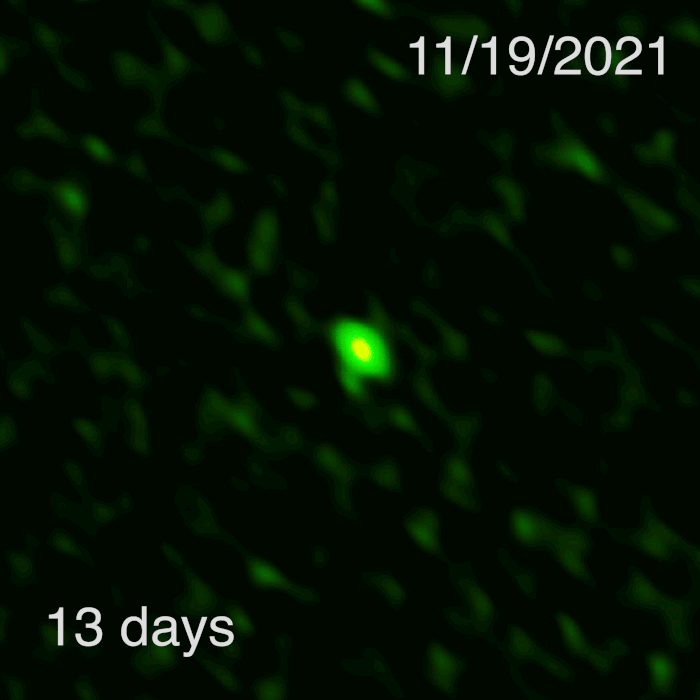The aftermath of an epic collision involving at least one neutron star has been captured for the first time in the millimeter range of radio frequency wavelengths.
The result is a recording of a short-duration gamma-ray burst – one of the most energetic ever observed, and one of the brightest lingering afterglows we've ever seen. The data can help scientists learn more about these extreme events, and the effect they have on the space around them.
And there's an incredible timelapse of the event, the light of which seems to have traveled some 6 to 9 billion light-years across the Universe, to be picked up by the Atacama Large Millimeter/Submillimeter Array (ALMA) in November 2021.
"This short gamma-ray burst was the first time we tried to observe such an event with ALMA," said physicist Wen-fai Fong of Northwestern University.
"Afterglows for short bursts are very difficult to come by, so it was spectacular to catch this event shining so bright. After many years of observing these bursts, this surprising discovery opens up a new area of study, as it motivates us to observe many more of these with ALMA, and other telescope arrays, in the future."
Bursts of gamma radiation are the most powerful known explosions in the Universe. In just 10 seconds, a gamma-ray burst can emit more energy than a star like the Sun gives off in 10 billion years.
And they're important; as we saw in the first neutron star collision ever observed, it's in explosions like these that elements heavier than iron are forged and ejected into the Universe. The gold ring you're wearing on your finger is the product of extreme stellar calamity.
We know that neutron star collisions produce a type of gamma-ray burst known as a short-duration gamma-ray burst, or SGRB. These last just milliseconds, and leave behind a bright afterglow as the ejecta from the explosion slams into and interacts with the gas of the interstellar medium.
Typically, these SGRBs are not observed in radio wavelengths, which can make them a little difficult to interpret.
"These explosions take place in distant galaxies which means the light from them can be quite faint for our telescopes on Earth," explained astrophysicist Tanmoy Laskar of Radboud University in the Netherlands.
"Before ALMA, millimeter telescopes were not sensitive enough to detect these afterglows."
 Timelapse of the event recorded by ALMA. (T. Laskar, S. Dagnello, ALMA [ESO/NAOJ/NRAO])
Timelapse of the event recorded by ALMA. (T. Laskar, S. Dagnello, ALMA [ESO/NAOJ/NRAO])
Because this particular event, named GRB 211106A, was so far away, it was not detectable by our current gravitational wave astronomy instruments. The energetic X-rays accompanying the brief explosion were picked up by NASA's Neil Gehrels Swift Observatory.
However, galaxies as distant as the host of GRB 211106A are not detectable in X-ray wavelengths – and the dust in the region meant that Hubble's optical observations were no better at pinpointing the source.
For that reason, scientists working with just the X-ray burst thought that the location of the explosion was relatively nearby. So they turned to ALMA, the first time millimeter-wavelengths had been used to try to observe and contextualize a gamma-ray burst event.
"The Hubble observations revealed an unchanging field of galaxies," Laskar said.
"ALMA's unparalleled sensitivity allowed us to pinpoint the location of the GRB in that field with more precision, and it turned out to be in another faint galaxy, which is further away.
"That, in turn, means that this short-duration gamma-ray burst is even more powerful than we first thought, making it one of the most luminous and energetic on record."
When neutron stars collide, the result is spectacular: an explosion accompanied by jets of material that erupt outwards at a significant percentage of the speed of light. If we're lucky, those jets are oriented in such a way that one is directed more or less towards us, so that we see the eruption as a gamma-ray burst.
The millimeter-wavelength observations allowed the researchers to measure some key properties of GRB 211106A; namely, the opening angle of the jet, which can be used to infer the rates of SGRBs in the Universe, and a more precise measurement of the energy of the GRB.
"Millimeter wavelengths can tell us about the density of the environment around the GRB," said astronomer Genevieve Schroeder of Northwestern University.
"And, when combined with the X-rays, they can tell us about the true energy of the explosion. Because emission at millimeter wavelengths can be detected for a longer time than in X-rays, the millimeter emission also can be used to determine the width of the GRB jet."
The researchers found that GRB 211106A has some unusual properties, both in its host galaxy, and its energetic profile.
This ultimately suggests that there is a greater diversity in the properties of SGRBs than is currently accounted for, which means continued observation and classification of these events is warranted.
So, while this may be the first millimeter foray into these incredible explosions, it's extremely unlikely to be the last.
"ALMA shatters the playing field in terms of its capabilities at millimeter wavelengths and has enabled us to see the faint, dynamic Universe in this type of light for the first time," Fong said.
"After a decade of observing short GRBs, it is truly amazing to witness the power of using these new technologies to unwrap surprise gifts from the Universe."
The research has been accepted into The Astrophysical Journal Letters, and is available on arXiv.
